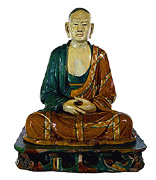
Liao dynasty, 907-1125 CE
From Yi county, Hebei province, China
Stoneware with three-color glaze
Height: 1.3 m
Acquisition number: #OA 1913.11-21.1
Gift of the National Art Collections Fund
Image courtesy of the British Museum (copyright reserved)
Images of lohan, the Chinese transliteration of the Sanskrit arhat, were a very important aspect of early Chinese Buddhism. In India, the arhat were the disciple of the historical Buddha Sakyamuni; they lived on after his passing in order to spread the Buddha's teachings. In China, however, the Lohan were merged with Daoist Immortals, learned sages who, through the deep concentration and the practice of certain Daoist rites and rituals, were believed to have gained magical powers, powerful insights into the workings of nature, and the secret to immortality. In China, lohan were often given unusual physical characteristics, such as misshapen heads, extremely thin frames and exceeding long eyebrows.
In comparison, this figure, made during the Liao dynasty and discovered in a temple-grotto in Hebei province, is relatively tame. Only the exceeding large ears offer any indication that this sculpture may be more than a portrait of an important monk, or the founding priest of a temple. This figure was found with seven others like it, which is half the usual number included in lohan groups, typically sixteen (though some painted versions of lohan groups can include many hundreds of figures in a single composition).
As noted by experts at the British Museum, the sculptural style used here closely follows that of the Tang dynasty (618-906 CE).1 This indicates that the Khitan patrons probably engaged Chinese craftsmen who worked in isolation in the northern Liao empire, away from stylistic developments occurring in Song-era Buddhist contexts in the Chinese provinces to the south. Another aspect worth mentioning is the so-called sancai or "three-color" glaze used to decorate the figure's robes, another preference of the Tang period adopted for the Khitan consumption. The bands of color on the lohan's yellow robe is intended to represent a patchwork garment known in Sanskrit as a kasaya, which was intended to function as a sign of humility2, though in fact these kasaya could oftentimes be made from extremely expensive silk brocades donated by wealthy patrons. For more on kasaya, see the section in the Buddhism section devoted to implements and icons.
(1) See the British Museum web page dedicated to this object.
(2) Ibid.